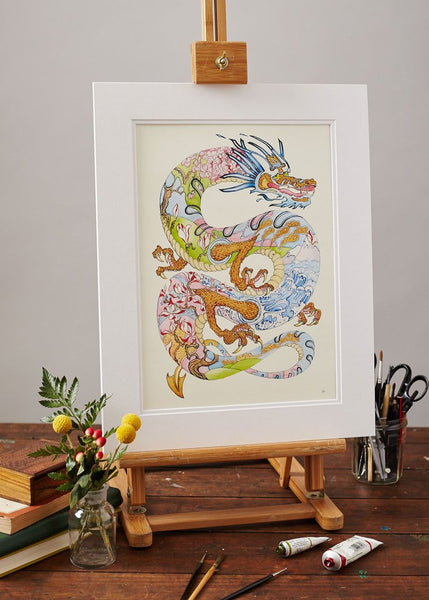The Dragon Dilemma

DM Collection Dragon design - available as an art print and greetings card.
Dragons are perhaps the most prominent mythical beast in modern times - from How to train your dragon to Game of Thrones the creatures inspire stories and adorn merchandising galore. A dragon is the only mythical beast to feature in the DM Collection, with this Chinese-inspired dragon design. But mention of dragons goes back centuries and spans cultures from our own patron saint in England to the longer-bodied Asian dragons.
European dragons tend to have short bodies, wings and long tails, with the required fearsome teeth and fiery breath. The earliest record of a fire-breathing dragon in Europe is in the epic poem Beowulf - the great hero is finally killed by a dragon which his comrade then slays. The Bible also features several references to reptilious monsters, which some scolars believe are dragons - though whether they are literal beasts of figurative representations of Satan is a matter for further debate. In the times of early Christianity, St George saved a village from a dragon by calling on Christ's help, inspiring them all to convert to Christianity which in turn led to his cannonisation. His daring feats continued and the Turkish-born knight is patron saint not only of England but of a dozen other towns and regions across Europe to Palestine.
Dragon bones are available to view across Europe still, with the most intact being in Wawel Cathedral in Krakow, Poland. European dragons seem to exist in folklore mainly as something for knights to prove their valour by slaying, and often thereby recovering a treasure which dragons accrue for reasons that remain obscure. Their association in Christianity with evil is also strong, making dragons a feared and reviled species.
On the other side of the Eurasian land mass, dragons are seen in an altogether different light. With snake-like bodies, squarer snouts and more prominent claws Chinese dragons are symbolic of power, strength, good luck and imperial authority. The dragon is in fact the most auspicious animal of the 12 creatures in the Chinese calendar. Depictions of dragons in China date back to the 5th millennium BC.
Fairly obvious explanations for the prevalence of dragons in folklore point to early findings of dinosaur remains. Other theories include stray or outsized reptiles, like crocodiles or snakes, finding their way to odd corners of the continent where they made their lairs. On the other hand, is it such a big stretch to believe that evolution threw up some fearsome creatures on the path between dinosaurs and lizards?
Daniel's Dragon design is available as an art print and greetings card.
Read more about the development of the design in Daniel's blog.

1 comment
There is certainly a great deal to find out about this subject.
I love all of the points you’ve made. http://www.yahoo.net/